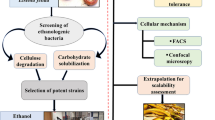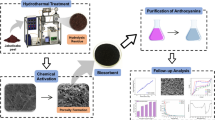Abstract
Vinasse from the distillation of winemaking residues is a wastewater characterized by high levels of aromatic compounds. Batch cultures of Phlebia rufa showed a significant (p < 0.05) correlation between laccase activity and initial vinasse concentration. The pattern of biodegradation of hydroxybenzoic acids, hydroxycinnamic acids and flavonoids, assessed by HPLC-DAD, revealed that p-hydroxybenzoic acid is the most recalcitrant compound. Vinasse-induced laccase showed electrophoretic homogeneity and molecular weight of 62 kDa after being purified 21-fold. Optimum pH for oxidation of 2,6-dimethoxyphenol (2,6-DMP) was 3.5 and optimum temperature was 50 °C, with an activation energy of 42.8 kJ mol−1. Catalytic efficiency of 2,2′-azinobis(3-ethylbenzthiazoline-6-sulfonic acid) oxidation is about two orders of magnitude higher than 2,6-DMP oxidation, being their Km values 36.2 ± 2.6 μM and 303.0 ± 44.7 μM, respectively and kcat values 486.1 s−1 and 179.6 s−1, respectively. Akaike information criterion and Akaike weights were used to discriminate inhibition models that best fitted 2,6-DMP oxidation in the presence of inhibitors. Inhibition constants of mixed-type inhibitors azide and fluoride, and competitive-type inhibitor chloride, showed the following inhibitors potency: azide > fluoride > chloride. Taken together, this study is consistent with the assumption that P. rufa could be a useful tool for aerobic degradation of phenolic-rich wastewaters.




Similar content being viewed by others
References
Aguiar MM, Ferreira LFR, Monteiro RTR (2010) Use of vinasse and sugarcane bagasse for the production of enzymes by lignocellulolytic fungi. Braz Arch Biol Technol 53:1245–1254. https://doi.org/10.1590/S1516-89132010000500030
Ahmed PM, Pajot HF, de Figueroa LIC, Gusils CH (2018) Sustainable bioremediation of sugarcane vinasse using autochthonous macrofungi. J Environ Chem Eng 6:5177–5185. https://doi.org/10.1016/j.jece.2018.08.007
Akaike H (1974) New look at statistical-model identification. IEEE Trans Automat Contr AC19:716–723. https://doi.org/10.1109/TAC.1974.1100705
APHA-AWWA-WEF (1995) Standard methods for the examination of water and wastewater, 19th edn. American Public Health Association, American Water Works Association, Water Environment Federation, Washington, DC, USA
Baldrian P (2006) Fungal laccases - occurrence and properties. FEMS Microbiol Rev 30:215–242. https://doi.org/10.1111/j.1574-4976.2005.00010.x
Bilal M, Rasheed T, Nabeel F, Iqbal HMN, Zhao YP (2019) Hazardous contaminants in the environment and their laccase-assisted degradation - A review. J Environ Manage 234:253–264. https://doi.org/10.1016/j.jenvman.2019.01.001
Bradford MM (1976) A rapid and sensitive method for the quantitation of microgram quantities of protein utilizing the principle of protein-dye binding. Anal Biochem 72:248–254. https://doi.org/10.1016/0003-2697(76)90527-3
Burnham KP, Anderson DR (2002) Model selection and multimodel interference: a practical information – theoretic approach, 2nd edn. Springer, New York
Cannatelli MD, Ragauskas AJ (2017) Two decades of laccases: advancing sustainability in the chemical industry. Chem Rec 17:122–140. https://doi.org/10.1002/tcr.201600033
Chmelová D, Ondrejovič M (2016) Purification and characterization of extracellular laccase produced by Ceriporiopsis subvermispora and decolorization of triphenylmethane dyes. J Basic Microbiol 56:1173–1182. https://doi.org/10.1002/jobm.201600152
Christofoletti CA, Escher JP, Correia JE, Marinho JFU, Fontanetti CS (2013) Sugarcane vinasse: Environmental implications of its use. Waste Manage 33:2752–2761. https://doi.org/10.1016/j.wasman.2013.09.005
Collins PJ, Dobson ADW (1997) Regulation of laccase gene transcription in Trametes versicolor. Appl Environ Microbiol 63:3444–3450. https://doi.org/10.1128/AEM.63.9.3444-3450.1997
Dana M, Bakhshi Khaniki G, Mokhtarieh AA, Davarpanah SJ (2017) Biotechnological and industrial applications of laccase: a review. J Appl Biotechnol Rep 4:675–679
Di Bari C, Mano N, Shleev S, Pita M, De Lacey AL (2017) Halides inhibition of multicopper oxidases studied by FTIR spectroelectrochemistry using azide as an active infrared probe. Biol Inorg Chem 22:1179–1186. https://doi.org/10.1007/s00775-017-1494-8
Dias AA, Bezerra RM, Pereira AN (2004) Activity and elution profile of laccase during biological decolorization and dephenolization of olive mill wastewater. Bioresour Technol 92:7–13. https://doi.org/10.1016/j.biortech.2003.08.006
Dias AA, Pinto PA, Fraga I, Bezerra RMF (2014) Diagnosis of enzyme inhibition using excel solver: a combined dry and wet laboratory exercise. J Chem Educ 91:1017–1021. https://doi.org/10.1021/ed3006677
Elisashvili V, Kachlishvili E, Asatiani MD (2018) Efficient production of lignin-modifying enzymes and phenolics removal in submerged fermentation of olive mill by-products by white-rot basidiomycetes. Int Biodeterior Biodegrad 134:39–47. https://doi.org/10.1016/j.ibiod.2018.08.003
Fernandes JMC, Sousa RMOF, Fraga I, Sampaio A, Amaral C, Bezerra RMF, Dias AA (2020) Fungal biodegradation and multi-level toxicity assessment of vinasse from distillation of winemaking by-products. Chemosphere 238:124572. https://doi.org/10.1016/j.chemosphere.2019.124572
Fernandes JMC, Fraga I, Sousa RMOF, Rodrigues MAM, Sampaio A, Bezerra RMF, Dias AA (2020) Pretreatment of grape stalks by fungi: effect on bioactive compounds, fiber composition, saccharification kinetics and monosaccharides ratio. Int J Environ Res Public Health 17:5900. https://doi.org/10.3390/ijerph17165900
Foukis A, Gkini OA, Stergiou P-Y, Papamichael EM (2018) New insights and tools for the elucidation of lipase catalyzed esterification, reaction mechanism in n-hexane: The synthesis of ethyl butyrate. Mol Catal 455:159–163. https://doi.org/10.1016/j.mcat.2018.06.004
Glazunova OA, Shakhova NV, Psurtseva NV, Moiseenko KV, Kleimenov SY, Fedorova TV (2018) White-rot basidiomycetes Junghuhnia nitida and Steccherinum bourdotii: Oxidative potential and laccase properties in comparison with Trametes hirsuta and Coriolopsis caperata. PloS One 13:6. https://doi.org/10.1371/journal.pone.0197667
Gonzalez T, Terron MC, Yague S, Junca H, Carbajo JM, Zapico EJ, Silva R, Arana-Cuenca A, Tellez A, Gonzalez AE (2008) Melanoidin-containing wastewaters induce selective laccase gene expression in the white-rot fungus Trametes sp I-62. Res Microbiol 159:103–109. https://doi.org/10.1016/j.resmic.2007.10.005
Hakulinen N, Rouvinen J (2015) Three-dimensional structures of laccases. Cell Mol Life Sci 72:857–868. https://doi.org/10.1007/s00018-014-1827-5
Heinzkill M, Bech L, Halkier T, Schneider P, Anke T (1998) Characterization of laccases and peroxidases from wood-rotting fungi (family Coprinaceae). Appl Environ Microbiol 64:1601–1606
Islam M, Yuan Q (2020) Fungal treatment of mature landfill leachate utilizing woodchips and wheat-straw as co-substrates. Biodegradation 31:109–122. https://doi.org/10.1007/s10532-020-09897-9
Kepp KP (2015) Halide binding and inhibition of laccase copper clusters: the role of reorganization energy. Inorg Chem 54:476–483. https://doi.org/10.1021/ic5021466
Laemmli UK (1970) Cleavage of structural proteins during the assembly of the head of bacteriophage T4. Nature 227:680–685. https://doi.org/10.1038/227680a0
Leitner C, Hess J, Galhaup C, Ludwig R, Nidetzky B, Kulbe KD, Haltrich D (2002) Purification and characterization of a laccase from the white-rot fungus Trametes multicolor. Appl Biochem Biotechnol 98:497–507. https://doi.org/10.1385/ABAB:98-100:1-9:497
Lucas MS, Dias AA, Bezerra RM, Peres JA (2008) Gallic acid photochemical oxidation as a model compound of winery wastewaters. J Environ Sci Health Part A-Toxic/Hazard Subst Environ Eng 43:1288–1295. https://doi.org/10.1080/10934520802177904
Mehra R, Muschiol J, Meyer AS, Kepp KP (2018) A structural-chemical explanation of fungal laccase activity. Sci Rep 8:17285. https://doi.org/10.1038/s41598-018-35633-8
Mills H, Jones JB Jr (1996) Plant analysis handbook II. MicroMacro Publishing, Athens, Georgia, USA
Min K-L, Kim Y-H, Kim YW, Jung HS, Hah YC (2001) Characterization of a novel laccase produced by the wood-rotting fungus Phellinus ribis. Arch Biochem Biophys 392:279–286. https://doi.org/10.1006/abbi.2001.2459
Moreno AD, Ibarra D, Eugenio ME, Tomas-Pejo E (2020) Laccases as versatile enzymes: from industrial uses to novel applications. J Chem Technol Biotechnol 95:481–494. https://doi.org/10.1002/jctb.6224
Patel H, Gupte S, Gahlout M, Gupte A (2014) Purification and characterization of an extracellular laccase from solid-state culture of Pleurotus ostreatus HP-1. 3 Biotech 4:77–84. https://doi.org/10.1007/s13205-013-0129-1
Pinto PA, Bezerra RMF, Dias AA (2018) Discrimination between rival laccase inhibition models from data sets with one inhibitor concentration using a penalized likelihood analysis and Akaike weights. Biocatal Biotransform 36:401–407. https://doi.org/10.1080/10242422.2018.1425401
Pinto PA, Fraga I, Bezerra RMF, Dias AA (2020) Phenolic and non-phenolic substrates oxidation by laccase at variable oxygen concentrations: Selection of bisubstrate kinetic models from polarographic data. Biochem Eng J 153:107423. https://doi.org/10.1016/j.bej.2019.107423
Raseda N, Hong S, Kwon OY, Ryu K (2014) Kinetic evidence for the interactive inhibition of laccase from Trametes versicolor by pH and chloride. J Microbiol Biotechnol 24:1673–1678. https://doi.org/10.4014/jmb.1408.08012
Riva S (2006) Laccases: blue enzymes for green chemistry. Trends Biotechnol 24:219–226. https://doi.org/10.1016/j.tibtech.2006.03.006
Santana TT, Linde GA, Colauto NB, do Valle JS, (2018) Metallic-aromatic compounds synergistically induce Lentinus crinitus laccase production. Biocatal Agric Biotechnol 16:625–630. https://doi.org/10.1016/j.bcab.2018.10.018
Saparrat MCN, Guillén F, Arambarri AM, Martínez AT, Martínez MJ (2002) Induction, isolation, and characterization of two laccases from the white rot basidiomycete Coriolopsis rigida. Appl Environ Microbiol 68:1534–1540. https://doi.org/10.1128/AEM.68.4.1534-1540.2002
Sousa RMOF, Amaral C, Fernandes JMC, Fraga I, Semitela S, Braga F, Coimbra AM, Dias AA, Bezerra RM, Sampaio A (2019) Hazardous impact of vinasse from distilled wine making by-products in terrestrial plants and aquatic organisms. Ecotox Environ Safe 183:109493. https://doi.org/10.1016/j.ecoenv.2019.109493
Strong PJ (2010) Fungal remediation of Amarula distillery wastewater. World J Microbiol Biotechnol 26:133–144. https://doi.org/10.1007/s11274-009-0152-x
Teixeira A, Eiras-Dias J, Castellarin SD, Gerós H (2013) Berry phenolics of grapevine under challenging environments. Int J Mol Sci 14:18711–18739. https://doi.org/10.3390/ijms140918711
Tobimatsu Y, Schuetz M (2019) Lignin polymerization: how do plants manage the chemistry so well? Curr Op Biotechnol 56:75–81. https://doi.org/10.1016/j.copbio.2018.10.001
Velioglu YS, Mazza G, Gao L, Oomah BD (1998) Antioxidant activity and total phenolics in selected fruits, vegetables, and grain products. J Agri Food Chem 46:4113–4117. https://doi.org/10.1021/jf9801973
Wagenmakers E-J, Farrell S (2004) AIC model selection using Akaike weights. Psychon Bull Rev 11:192–196. https://doi.org/10.3758/BF03206482
Wu Y, Teng Y, Li Z, Liao X, Luo Y (2008) Potential role of polycyclic aromatic hydrocarbons (PAHs) oxidation by fungal laccase in the remediation of an aged contaminated soil. Soil Biol Biochem 40:789–796. https://doi.org/10.1016/j.soilbio.2007.10.013
Xu F (1996) Oxidation of phenols, anilines, and benzenethiols by fungal laccases: correlation between activity and redox potentials as well as halide inhibition. Biochemistry 35:7608–7614. https://doi.org/10.1021/bi952971a
Zhuo R, Yuan P, Yang Y, Zhang S, Ma FY, Zhang XY (2017) Induction of laccase by metal ions and aromatic compounds in Pleurotus ostreatus HAUCC 162 and decolorization of different synthetic dyes by the extracellular laccase. Biochem Eng J 117:62–72. https://doi.org/10.1016/j.bej.2016.09.016
Acknowledgements
J.M.C.F. is recipient of a fellowship supported by INNOVINE&WINE - Innovation Platform of Vine and Wine, Project NORTE-01-0145-FEDER-000038, co-funded by FEDER/COMPETE/POCI under Project POCI-01-0145-FEDER-006958; this work was also supported by FCT - Portuguese Foundation for Science and Technology under project UIDB/04033/2020.
Author information
Authors and Affiliations
Corresponding author
Ethics declarations
Conflict of interest
Authors declare they do not have conflict of interest.
Additional information
Publisher's Note
Springer Nature remains neutral with regard to jurisdictional claims in published maps and institutional affiliations.
Supplementary Information
Below is the link to the electronic supplementary material.
Rights and permissions
About this article
Cite this article
Fernandes, J.M.C., Fraga, I., Bezerra, R.M.F. et al. Removal pattern of vinasse phenolics by Phlebia rufa, characterization of an induced laccase and inhibition kinetics modeling. Biodegradation 32, 287–298 (2021). https://doi.org/10.1007/s10532-021-09936-z
Received:
Accepted:
Published:
Issue Date:
DOI: https://doi.org/10.1007/s10532-021-09936-z




